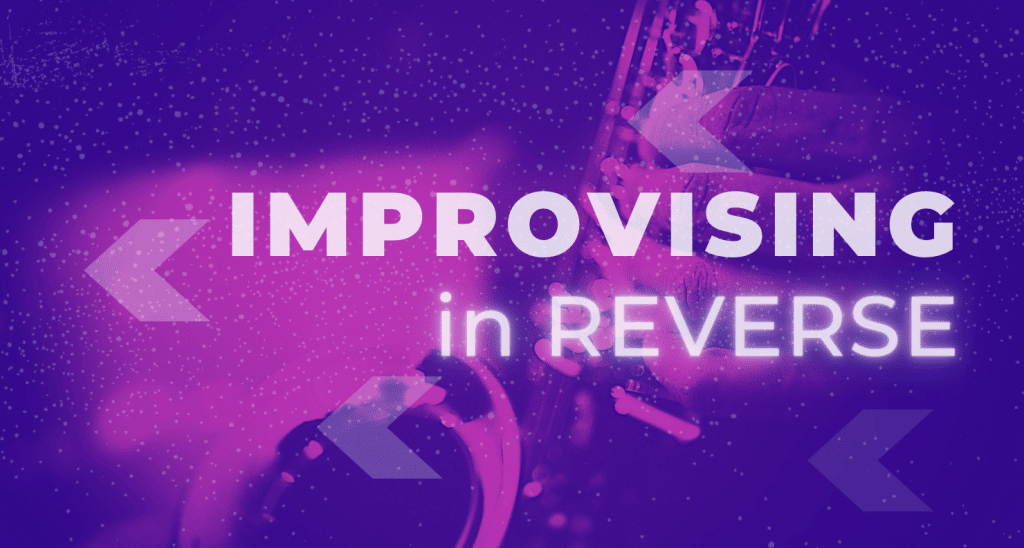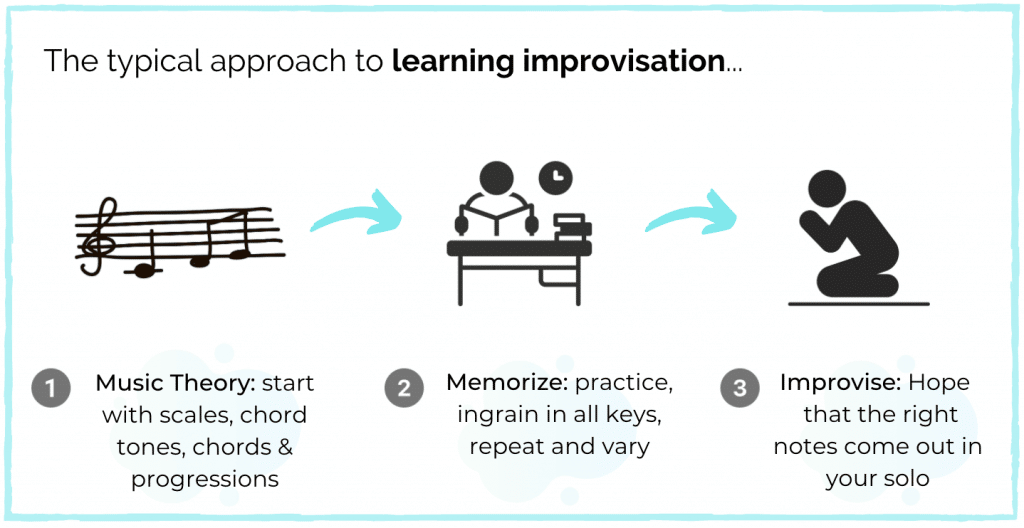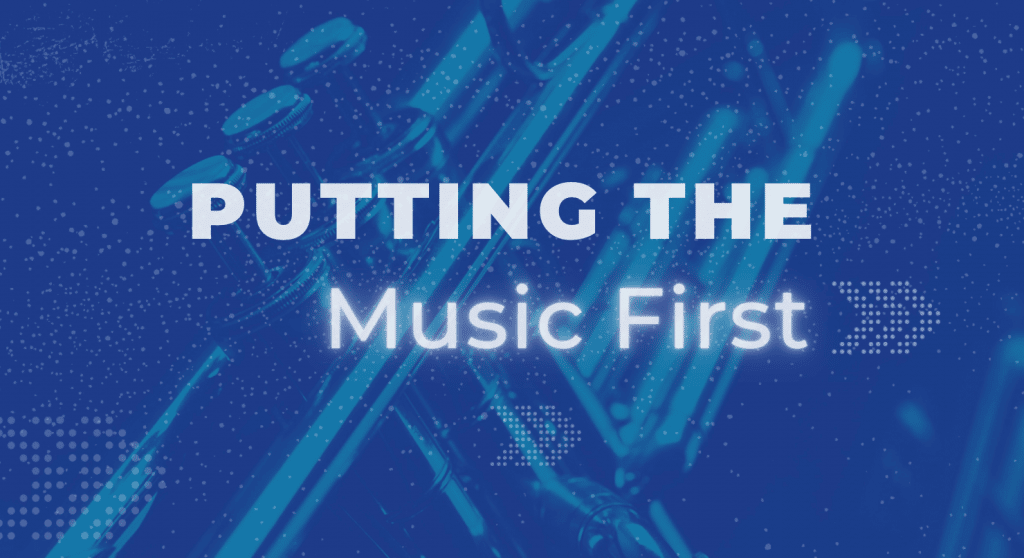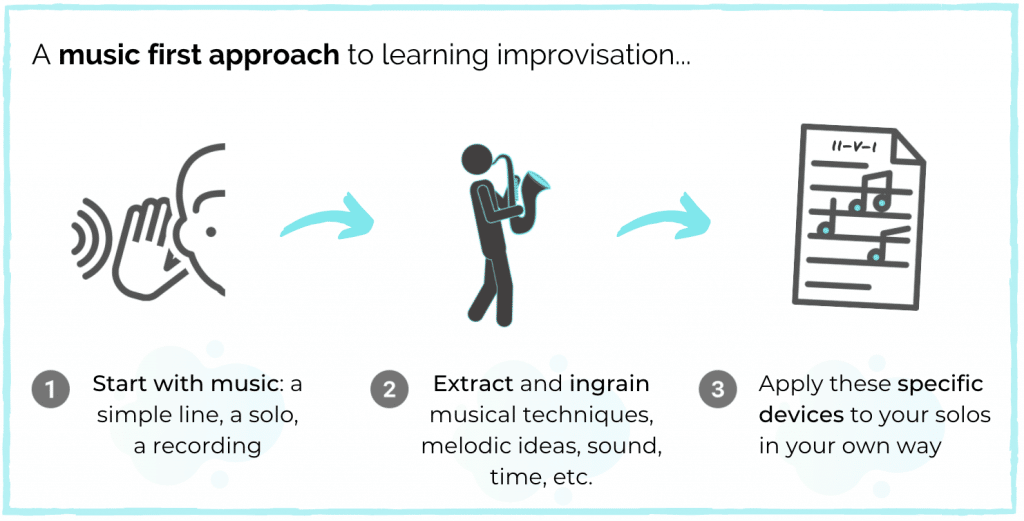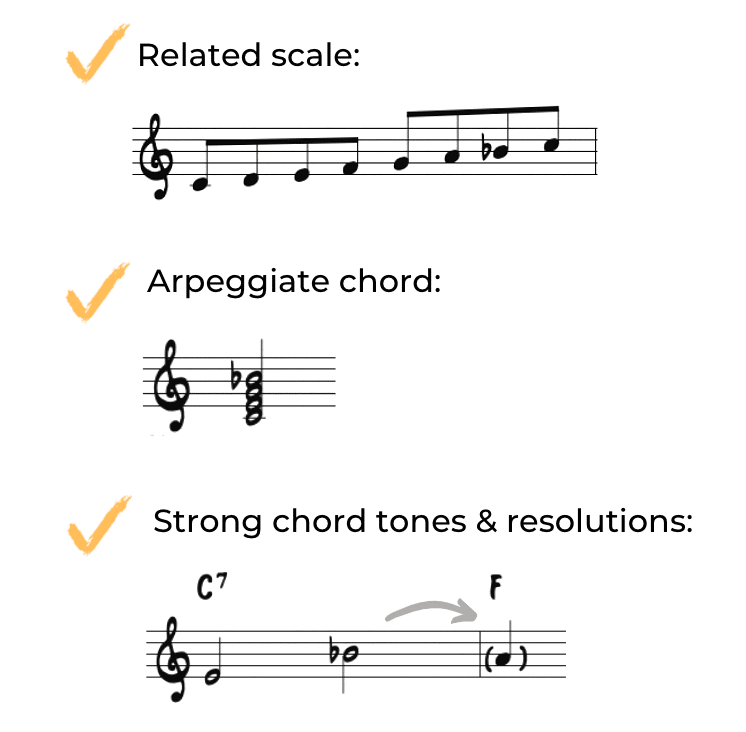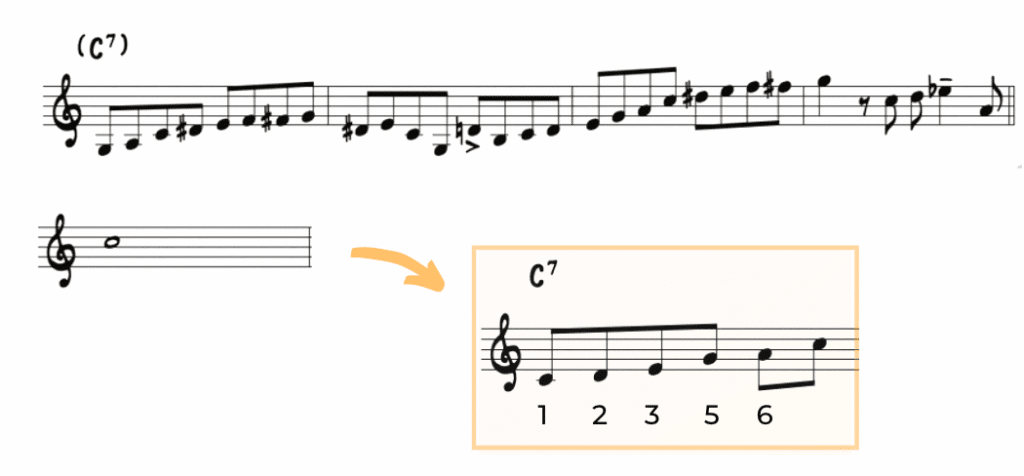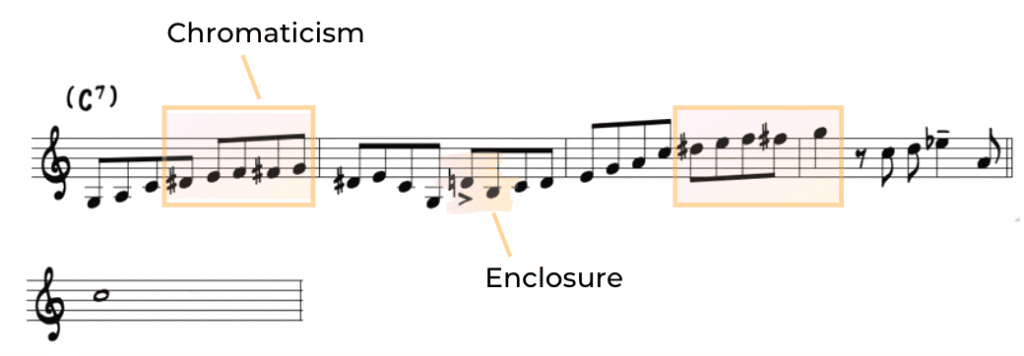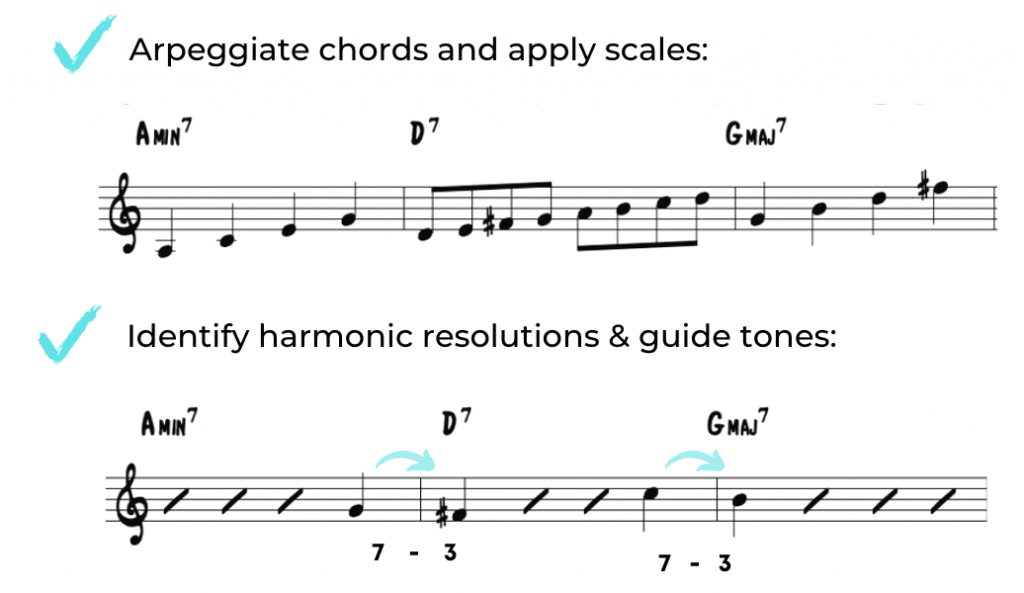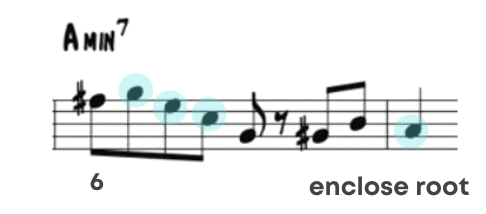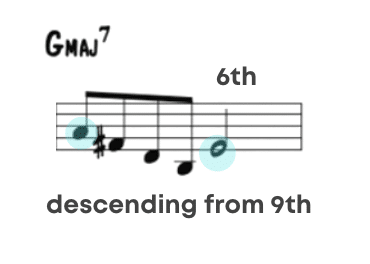You learn scales. You faithfully practice triads and arpeggios in every key. You memorize chord progressions & learn tunes. And then you improvise…
Sound familiar? This is the standard approach to jazz improvisation that you find in classrooms, private lessons, masterclasses, and practice rooms everywhere. It’s what we’ve come to accept as “the way” to becoming a proficient improviser.
But is this really all that it takes to play an amazing solo??
The truth is that this prescribed improvisation process can often feel like an exercise, mixing and matching notes over chord progressions. Sure the tunes may change, and the style of music or tempo might be different, but at the end of the day you’re confronted with the same challenge…
Trying to piece together related notes, scales, and chord tones to somehow create interesting musical ideas.
It’s frustrating trying to come up with ideas from scratch using music theory – I know. And it’s exactly why I hear so many students say “I feel like I’m not really improvising…I keep using the same scales…How do I play longer lines and connect chords?”
These problems are much more common then most players realize…
It comes down to the fact that we’ve been taught to approach the process of improvisation in reverse! To start with all the pieces and parts of our goal, but never learning how to put it all together – essentially trying to reverse engineer amazing solos from a bunch of music theory pieces.
This one-sided approach to learning improvisation can cause a lot of confusion and discouragement. You’re putting in the practice time and ingraining technique, but it’s not actually helping you improve.
However, here’s the thing we forget – you don’t have to guess every time you solo or resign yourself to piecing together scales and chords! The blueprint for creating great melodic lines and learning melodic skills is contained in the music we listen to everyday.
The key is starting with this musical information, instead of trying to end up there by chance.
I’ll show you what I mean…
Putting music theory before music
As we mentioned above, the typical approach common in a lot of jazz education revolves around the individual elements of music theory…
From our first lessons we dive headfirst into this world of definitions and rules, believing that this is where all of our musical ideas are going to come from. The expectation is that with enough repetition, with enough hours in the practice room all of those pieces will eventually click into place.
And when it’s time to improvise we’re almost relying on chance, hoping for a moment of inspiration that will turn this information into a musical phrase.
But in this sequence, we never talk seriously about the big picture of what we’re trying to do. About how to use this theory information in a musical way, about the characteristics of melody, or the specific skills that go into creating a melodic line.
It’s a bunch of information without enough emphasis on the skills required to use it. And this is a combination that doesn’t work, regardless of what you’re trying to learn…
Imagine giving someone all the ingredients for a three-course meal, but not telling them the recipe or teaching them the cooking techniques needed to prepare it. Just tossing the raw materials at them and saying “Ok, get to work!”
You wouldn’t do this and expect to get good results, just like you wouldn’t give an aspiring playwright a list of words and grammar rules and expect them to come up with Shakespeare.
…and it’s exactly why you shouldn’t expect a musician starting with a few scales and chord progressions to suddenly start improvising like Charlie Parker. No amount of memorization or practice with this approach is going to give you your desired result!
Remember, just because you have the information doesn’t mean that you know how to use it or that you have the necessary skills to start improvising with it…
The hard thing for many players to come to terms with, and something that I had to face myself, is that simply understanding theory and practicing scales doesn’t mean that you can suddenly improvise melodic lines.
You need to realize that understanding a Major chord doesn’t mean that you can play musical ideas over it, that simply running arpeggios over a chord progression doesn’t translate to the skill of improvising melodic lines.
…that showing up to play a tune with the chords and melody memorized isn’t a guarantee for a great solo.
The sooner you realize that theory is just one piece of the puzzle and reconnect with the bigger picture of why you’re playing, the sooner your improvising will noticeably improve.
Start with the music
It’s a given that every musician needs to understand theory and have some technique, but improvising requires more than this…
It requires creating melodies in the moment, of putting all of your theory and technique together to tell a story – and this is a skill in and of itself.
Our job is not to pass a music theory test over a chord progression or to play exercises in all keys – it’s to create music! This is why you need to study the art of creating musical lines, to develop the actual skills of crafting melodic ideas and implementing them in the tunes you play.
This information doesn’t come in a book of scale patterns or an etude, and it’s not hidden in a scale. It comes from the music itself – the great melodies, chord progressions, and solos that you love to listen to.
It’s tied to the culture of the music, to the players themselves, their musical personalities, their sound, and their time…Rather than spending hours trying to reverse-engineer a bunch of scales and chords into a musical solo, start with the musical idea itself!
You’re looking for a model of how to create musical statements over the chord, progressions, and tunes…
This doesn’t mean that you have to abandon all of the theory knowledge you’ve learned or the technique that you’ve practiced, you’re simply taking all of that information and going one step further.
The process here is simple. Find a musical source – a melody, a piece of language, a solo phrase – then deconstruct it and figure out what makes it tick.
It doesn’t have to be long or complex, just start with a simple line that grabs your ears. Isolate it, transcribe it, and ingrain it – then ask yourself, why do I like this musical phrase, how is it put together?
What can I take from this musical example in terms of technique, harmony, rhythm & sound to apply to my own approach to improvisation?
With this approach you’re actually learning the art of improvisation and how to create melodic ideas from the masters of the art form, instead of struggling to cobble together the pieces on your own.
Below we’ll show you two examples of how to get back on track with this process and reconnect to the music in your journey as an improviser…
One Chord: Theory vs. Music
To illustrate this point, let’s start by looking at the difference between these two approaches over a single chord…a regular old C7:
A standard theory approach tells us that the answer to playing the right notes lies in finding the related scale, arpeggiating the chord, and understanding the strong chord tones and their resolutions:
We know that a C7 contains these “ingredients”…however, we don’t exactly know where, when, or how to use them in a musical way or even how to apply them to an actual chord progression – it’s still just information.
So we just kinda guess, play scale fragments and arpeggios, a lick we learned…
Rather than memorizing the pieces of this sound, we need to learn the specific skills of approaching this chord in a melodic way. How to put everything together so we can start making our own musical ideas.
And this means starting with a musical approach, a blueprint for something that actually sounds like music…
Oscar Peterson, C Jam Blues
If you want to learn how to play over a dominant chord, the Blues is a great place to start. And if you want to learn how to create swinging melodic lines, there’s no better guide than the great Oscar Peterson.
Check out his solo on C Jam Blues…
At [0:35] in the recording he plays the following line:
This is a musical idea, it’s language. It has sound, time, swing, and shape. You’re not thinking about scales or chords when you hear it. This is the approach we want to have when we are improvising!
Once you have the musical idea in your ear and the line under your fingers, it’s time to break it down into specific techniques, to extract the melodic, harmonic, and rhythmic devices that make it work.
Here are a few places you might start…
What is the melodic skeleton of the line?
Take the line and determine the underlying chord(s). How does this chord relate to the larger progression or surrounding chords?
Look at which notes or chord tones are being used over this chord. At its core, what is the melodic skeleton of this line?
In this specific line the melodic framework is created around the notes of a major pentatonic scale, or the 1, 2, 3, 5 & 6 of the C dominant sound:
It’s important to note here the difference between this approach to a “major pentatonic scale” within a musical context and a 5 note scale without any musical qualities or application. This is why you need to incorporate a musical approach.
The goal is not just to identify the notes, but to find out why they are used, how they are played, and the musical devices behind them.
Identify Melodic techniques & devices
Next, determine which techniques Oscar is using to create linear motion and shape his lines.
In this example you find him using chromatic movement and enclosure to highlight specific goal notes:
To that basic pentatonic framework he adds interest by incorporating chromatic motion between the 3rd and 5th of the sound and adding emphasis to strong chord tones with enclosure.
These are devices that you can apply to any chord and the melodic instructions for applying can be found by studying this line.
Identify Harmonic tactics
Finally take a look at how he is approaching the C7 chord from a harmonic standpoint.
In this line he is emphasizing the flat 3rd of the C7 in three places:
Utilizing blues language and blue notes over a dominant chord.
With each of these steps make sure you are also studying the rhythmic components of the line. Which beat does the line start on? How is he phrasing? Which notes is he accenting?
Also strive to absorb the emotion, the swing feel, and the general vibe of the line along with the notes – this is just as vital. Use the same process for every type of chord that you are working on.
This is a multi-faceted approach to musical information. You have concrete techniques that are based in music and that you can apply to your solos, and this is going to pay off when you start improvising.
A musical approach to progressions: ii-V-I
Along with individual chords, you should also be taking a music first approach to harmonic movement and chord progressions.
For example, take the ii-V-I progression:
With a standard theory approach you are once again swimming in scales, arpeggios, and guide tone lines:
Again, this is all good information to know, but it’s not a musical approach.
Instead, look at it as the prerequisite information that you need to have in your mind, technique, and ears before you learn the skill of improvising.
Now let’s start from the vantage point of music…
Sonny Rollins, Pent-up House
As we did with the C7 chord above, let’s take a musical phrase over a ii-V and break it down into musical techniques that we isolate, learn, and apply to our own solos.
For some musical guidance, we’ll check out the one and only Sonny Rollins and his solo over the tune Pent-up House. Listen to how he approaches the ii-V’s in this tune…
At [2:59] in the solo he plays the following phrase:
This is one musical statement over a ii-V-I progression. Not a scale, not a guide tone line, but a musical idea with time, shape, and feeling.
Now your task is to ingrain the line in your ear, learn it on your instrument, and uncover the musical techniques at work.
Start by learning the line as a complete musical phrase. As you do this become aware of which chord you are playing over, which chord tone you’re on, and how the line moving from chord to the next.
And like you did with the individual chord, look for melodic and harmonic devices that he is using to navigate this progression. For instance, he is utilizing enclosure in the second and third measures:
Once you can visualize these aspects of the line and play it, transfer it to all keys:
Along with learning techniques for the entire progression, you can also isolate techniques from this line that relate to each specific chord:
- Minor techniques (ii chord)
- Dominant techniques (V7 chord)
- Major techniques (I chord)
From one simple ii-V line you can extract countless musical ideas and techniques.
Time to reverse your approach
The process that we highlighted above is not something that happens overnight…
It’s a mindset and approach that you have to integrate into your daily practice routine.
When it’s time to solo, don’t just settle for improvisation being an exercise in scales and thinking about guide tone lines. Go that extra step and strive to play musical ideas.
Approach everything that you play from the standpoint of music! Remember, theory is a useful tool that serves your musical ideas, but it’s not the musical idea itself.
If you want some extra guidance in this process of developing melodic ideas and gaining powerful musical techniques for your solos, check out our Melodic Power course!
The next time you find yourself learning a tune, memorizing a progression, or practicing a scale, be sure to ask yourself one question…
Am I starting with the music??

